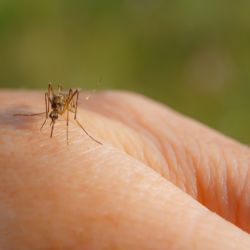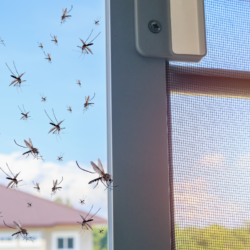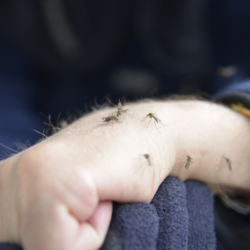Mosquito-borne parasites represent a major challenge to global public health, particularly malaria and lymphatic filariasis. Malaria, caused by parasites of the genus Plasmodium, is transmitted by Anopheles mosquitoes and affects millions of people every year, mainly in sub-Saharan Africa. Lymphatic filariasis, caused by parasitic worms such as Wuchereria bancrofti, is spread by Culex, Anopheles and Aedes mosquitoes, causing considerable disability and suffering. This article explores the transmission mechanisms, symptoms, and prevention and treatment strategies for these serious parasitic diseases.
Malaria: A constant battle against an invisible killer
Malaria is a serious parasitic disease caused by protozoa of the genus Plasmodium and transmitted by Anopheles mosquitoes. Present mainly in tropical and subtropical regions, malaria causes millions of cases every year. It is responsible for hundreds of thousands of deaths, mainly among children under the age of five. Symptoms of malaria include fever, chills, headaches and muscle aches. These can progress to severe complications such as anaemia, organ failure and death if treatment is not administered quickly.
What are the symptoms of the disease?
Malaria is caused by parasites of the genus Plasmodium, transmitted by Anopheles mosquitoes. These mosquitoes, which are active mainly at night, are found in tropical and intertropical areas, particularly in Africa. Four species of Plasmodium cause human malaria: Plasmodium falciparum, Plasmodium vivax, Plasmodium malariae and Plasmodium ovale. P. falciparum and P. vivax are the most common, with P. falciparum being the most severe.
Symptoms generally appear 7 to 15 days after the infecting bite. They include fever, headache, vomiting and muscle pain. If left untreated for 24 hours, P. falciparum can progress to a severe form. In this case, it affects the neurological, respiratory and cardiac systems, as well as the blood cells and liver. The P. vivax and P. ovale forms can cause relapses weeks or months after the first infection, due to dormant forms in the liver.
Diagnosis is based on the detection of parasites in the blood, and treatment uses specific antiparasitic drugs. Early intervention reduces the intensity of the malaria attack, a potentially fatal infectious disease transmitted by Anopheles mosquitoes.
What can be done?
Lymphatic Filariasis: Understanding and preventing a debilitating disease
Lymphatic filariasis, also known as elephantiasis, is a parasitic disease caused by filarial worms such as Wuchereria bancrofti, Brugia malayi and Brugia timori. Transmitted by several types of mosquito, this disease affects the lymphatic system. It causes severe swelling and deformities of the limbs and genitals. Present in many tropical and subtropical regions, lymphatic filariasis affects millions of people. It can lead to physical disability and significant social stigma. Prevention and treatment efforts include the distribution of antiparasitic drugs, mosquito vector control and education of populations at risk.
How does the disease manifest itself?
Lymphatic filariasis, commonly known as “elephantiasis”, is a tropical disease found in Africa and Asia, caused by filarial worms. These parasites, transmitted to humans in the form of larvae via mosquitoes ( Culex, Anopheles and Aedes genera), penetrate the lymphatic vessels where they become adults, living for 6 to 8 years and producing millions of microfilariae.
The initial symptoms are often asymptomatic, but the disease damages the lymphatic system, causing kidney damage and impaired immunity. Later, visible signs appear: lymphoedema (swelling of the tissues), elephantiasis of the limbs and, in men, hydrocele (swelling of the scrotum).
Diagnosis is based on the detection of microfilariae in the blood, taken at night, and serology to identify antibodies. Treatment involves antiparasitic drugs such as diethylcarbamazine,ivermectin and albendazole, sometimes combined with antibiotics such as doxycycline.
What can be done about it?
Filariasis is mainly found in tropical regions of Asia, Africa, Central and South America. It will affect around 51.4 million people in 2020, although only a third of them will show any signs of the disease. The WHO proposed the eradication of this disease as early as 1997, with a programme launched in 2000 under the aegis of the Global Alliance to Eliminate Lymphatic Filariasis. Significant progress has been made, particularly in the Far East, although less so in Africa.
In 2020, the elimination programme will continue. It aims to interrupt transmission of the disease through mass drug administration and to treat cases of morbidity. Despite the impact of the Covid-19 pandemic on mass drug administration activities, progress has been made. Currently, 72 countries are endemic, 48 of which require mass drug administration.
The WHO recommends repeated preventive chemotherapy every year to halt the spread of infection. Since 2000, more than nine billion treatments have been administered. In 2018, 51 million people were infected, representing a 74% reduction since the start of the programme. Thanks to these efforts, 740 million people no longer need preventive chemotherapy. The WHO is also promoting mosquito control to reduce transmission of the disease.





